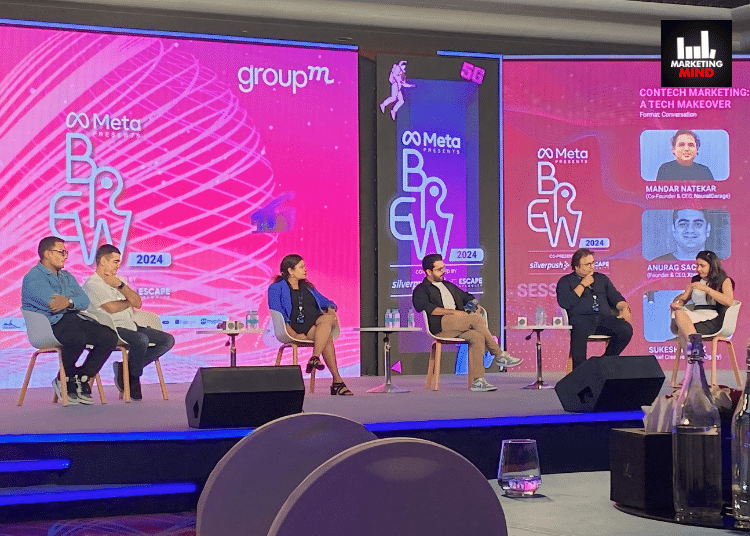The Indian adland in the modern contemporary times has undergone a seismic shift where brands are no more centered towards making only ads but focussing on ‘content’ and ‘technology’ to engage with audiences as part of their marketing plans.
Taking the center stage one of the panels of GroupM’s Brew 2024, the media investment arm of GroupM brought this very change into the fore and invited Sukesh Nayak, Chief Creative Officer, Ogilvy India; Milva Povo, Director of Sales- India, Seedtag; Anurag Sachdeva, Founder and CEO, Xtendr; Mandar Natekar, Co-Founder and CEO, NeuralGarage and Filmmaker Shakun Batra to share their views on how content in today’s ad world is undergoing a tech makeover as part of larger scheme of ConTech Marketing things.
Moderated by Mukti Kumaran, VP- Client Leadership (mSix& Partners), GroupM, the session titled ‘ConTech Marketing: Content gets a Tech Makeover’ kickstarted with the moderator explaining how marketing is all about telling stories that can resonate with people and how technology as a tool is enabling people to do the same in ways that have never been thought before, that too with personalization driving engagement and interactivity.
She also borrowed a line from WPP’s Emerging Tech Lead- Niraj Ruparel who often quotes the line- ‘There are 8.8 billion people on this planet and there is no way you can personalize until you are using technology like a generator’ to begin the panel discussion.
Following this, she opened her pandora box of questions, beginning with Ogilvy’s Nayak, to whom she asked as to how he, as a creative professional, has seen the process of storytelling evolving with the influence of content and technologies such as AI, VR, AR, etc. and whether personalization should be done on all content pieces.
Responding to her question, Nayak shared the viewpoint that what Ogilvy is being able to do in today’s time wouldn’t be possible in the earlier days when technology wasn’t as vast as it is today and that for the WPP-owned creative agency what really matters is how does it help brands connect with their consumers in innovative ways that are not just farfetched concepts but executable ideas.
Sharing the example of one of Ogilvy India’s most celebrated ad campaigns- Cadbury Celebrations’ SRK My Ad, he mentioned that he couldn’t have imagined going to a meeting and pitching a concept like that without having the assurance of doing it because at the end of day, he believes that what creative agencies work towards is creating magic and for the same, it is technology that actually helps them in telling stories to consumers in a never before manner.
“You cannot take a substandard idea and couple it with good technology, hoping it’ll become amazing. For building something truly magical, you need to have the most cutting-edge concept and ideas first, and once you have that in place, technology becomes a phenomenal tool to make the impossible happen, including doing personalization at scale. So, if you treat a bad idea and concept with great tech, that’s not going to work and it will only end up looking like a brochure or a leaflet,” he said.
Having said that, Nayak also advised people in the advertising and marketing industry to ‘be brave’ because that has been the only thing which has enabled himself, personally, to be able to think differently and push himself to make good ideas happen.
“Today in 2024, we are enjoying the act of creating all the more because the possibilities that we have today are incredible. So, be brave and buy the concepts that make you feel worried or even give you sleepless nights because the reality is if it seems too easy, it’s not going to be good enough, even when it is executed with the best craft possible,” he said.
Picking from here, Xtendr’s Sachdeva also highlighted that while technology, as per him, does help in driving deeper engagement, what is of utter importance today is having the ‘right content’ because technology standalone cannot do a makeover.
“If you look at it, the communication space started with text, which was one dimensional, then came television, which was two dimensional, and then we have the gaming ecosystem which in a way is 2.5 dimensional and now we are moving towards a three dimensional world. All of this is happening because technology is enabling it and hence content creators and thinkers need to start thinking in that manner because that’s where engagement starts to build,” he suggested.
Furthermore, he also highlighted that what Xtendr does in today’s time, primarily, is bring to life magic via value-augmented reality and artificial intelligence and drive over 100 million engagement within Asia Pacific across all of its brands.
“Whether it’s a print ad, a notebook or can of Coke, everything today can come to life with technology, so much so that even the audience can experience it all. And therefore, it is being consumer-first that remains as is and the selection of the right technology as an add-on which actually makes the magic happen,” he said.
Taking the conversation forward, Seedtag’s Povo drew the audience’s attention to how AI in a span of one year has transformed its consumption game massively. She highlighted how today the world is seeing so many ways in which one can use AI dynamically, albeit in the creative side, technology or in the way one addresses everything.
“Ad Seedtag, we have our own proprietary AI tech called Liz and what it actually does is analyze algorithms while users are instantly reading articles and then come up with contextual ads while targeting users across the open web. That being said, like all things, technology also comes at a price- for brands that are willing to pay to push the bar and meet both ends it is imperative to understand that one cannot do contextual without knowing how to leverage and utilize AI,” she said.
Adding to this, NeuralGarage’s Natekar also highlighted that when any form of content- be it short or long form, is created, it is the language which needs to be in multiple options so as to speak to the relevant audiences and therefore what ends up getting lost in most cases today is authenticity.
“Here is precisely when AI emerges to rescue and therein lies a paradox- ‘Artificial makes it look natural’ which makes one believe that technology can be used to make dubbed content look authentic and natural in every language. By using technology, one can transform content in a way that is able to talk to multiple consumers at the same time making them feel as if it has been made for them and that is a very high level of personalization. However, in the absence of technology, one would have to shoot in multiple languages and incur production costs as well. But as Sukesh rightly mentioned, it is technology which cannot come first instead of a great concept and idea and that is where technology helps create a narrative in multiple languages,” he added.
Responding to a question on whether or not he thinks that technology takes away the humanness of storytelling, filmmaker Batra emphasised how advertising is a great place to test innovation and that today where we are with technology, he believes that it is actually making lives easier and the storytelling experience more intimate.
“I think in the next five years, we will have a 20 year old kid who will have the toolkit to make what, let’s say, a Sanjay Leela Bhansali is putting out now,” he said.
Concludingly, Ogilvy’s Nayak once again reiterated that he strongly believes that technology is a tool that will enable one to make all the impossible things happen. “If we are substandard in our thinking, output will be substandard and if we settle for average, it will be average,” he said.
















